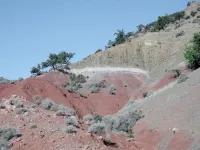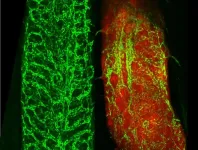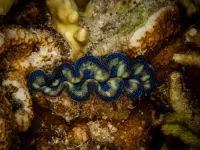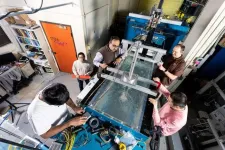(Press-News.org)
201.6 million years ago, one of the Earth's five great mass extinctions took place, when three-quarters of all living species suddenly disappeared. The wipeout coincided with massive volcanic eruptions that split apart Pangaea, a giant continent then comprising almost all the planet's land. Millions of cubic miles of lava erupted over some 600,000 years, separating what are now the Americas, Europe and North Africa. It marked the end of the Triassic period and the beginning of the Jurassic, the period when dinosaurs arose to take the place of Triassic creatures and dominate the planet.
The exact mechanisms of the End Triassic Extinction have long been debated, but most prominent: Carbon dioxide surfaced by the eruptions built up over many millennia, raising temperatures to unsustainable levels for many creatures, and acidifying the oceans. But a new study says the opposite: cold, not warmth was the main culprit. The study presents evidence that instead of stretching over hundreds of thousands of years, the first pulses of lava that ended the Triassic were stupendous events lasting less than a century each. In this condensed time frame, sunlight-reflecting sulfate particles were spewed into the atmosphere, cooling the planet and freezing many of its inhabitants. Gradually rising temperatures in an environment that was hot to begin with—atmospheric carbon dioxide in the late Triassic was already three times today's level—may have finished the job later on, but it was volcanic winters that did the most damage, say the researchers.
"Carbon dioxide and sulfates act not just in opposite ways, but opposite time frames," said lead author Dennis Kent of the Columbia Climate School's Lamont-Doherty Earth Observatory. "It takes a long time for carbon dioxide to build up and heat things, but the effect of sulfates is pretty much instant. It brings us into the realm of what humans can grasp. These events happened in the span of a lifetime."
The study was just published in the journal Proceedings of the National Academy of Sciences.
The Triassic-Jurassic extinction has long been thought tied to the eruption of the so-called Central Atlantic Magmatic Province, or CAMP. In a groundbreaking 2013 study, Kent and colleagues provided perhaps the most definitive link. Kent, who studies paleomagnetism, identified a consistent polarity reversal in sediments just below the initial CAMP eruptions, which showed they all happened at the same time across what are now widespread parts of the world. Colleagues then used radioactive isotopes to date the start of volcanism to 201,564,000 years ago, give or take a few tens of thousands of years. Scientists were unable to say how big the initial eruptions were, but it was assumed by many that the massive CAMP deposits must have taken many millennia to build up.
In the new study, Kent and colleagues correlated data from CAMP deposits in the mountains of Morocco, along Nova Scotia's Bay of Fundy, and New Jersey's Newark Basin. Their key evidence: the alignments of magnetic particles in the rocks that recorded the past drifting of Earth's magnetic pole at the time of the eruptions. Due to a complex set of processes, this pole is offset from the planet's unchanging axis of rotation—true north—and to boot, changes position by a few tenths of a degree each year. (The reason that compasses do not point exactly north.) Because of this phenomenon, magnetic particles in lavas that were emplaced within a few decades of each other will all point in the same direction, while ones emplaced, say, thousands of years later will point 20 or 30 degrees in a different direction.
What the researchers found was five successive initial CAMP lava pulses spread over about 40,000 years—each with the magnetic particles aligned in a single direction, indicating the lava pulse had emerged in less than 100 years, before drift of the magnetic pole could manifest itself. They say that these huge eruptions released so many sulfates so quickly that the sun was largely blocked out, causing temperatures to plunge. Unlike carbon dioxide, which hangs around for centuries, volcanic sulfate aerosols tend to rain out of the atmosphere within years, so resulting cold spells don't last very long. But due to the rapidity and size of the eruptions, these volcanic winters were devastating. The researchers compared the CAMP series to sulfates from the 1783 eruption of Iceland's Laki volcano, which caused widespread crop failures; just the initial CAMP pulses were hundreds of times greater, they say.
In sediments just below the CAMP layers lie Triassic-era fossils: large terrestrial and semiaquatic relatives of crocodiles, strange tree lizards, giant, flat-headed amphibians, and many tropical plants. Then they disappear with the CAMP eruptions. Small feathered dinosaurs had been around for tens of millions of years before this, and survived, eventually to thrive and get much larger, along with turtles, true lizards, and mammals, possibly because they were small and could survive in burrows.
"The magnitude of the environmental effects are related to how concentrated the events are," said study coauthor Paul Olsen, a paleontologist at Lamont-Doherty. "Small events spread out over [tens of thousands of years] produce much less of an effect than the same total volume of volcanism concentrated in less than a century. The overarching implication being that the CAMP lavas represent extraordinarily concentrated events."
* * * * *
The study was coauthored by Huapei Wang of China University of Geosciences, Morgan Schaller of Rensselaer Polytechnic Institute and Mohammed Et-Touhami of Morocco's Université Mohamed Premier.
Scientist contacts:
Dennis Kent dvk@ldeo.columbia.edu
Paul Olsen: polsen@ldeo.columbia.edu
END
Dinosaurs thrived after ice, not fire, says a new study of ancient volcanism
The Triassic-Jurassic extinction was a very sudden event, researchers assert
2024-10-28
ELSE PRESS RELEASES FROM THIS DATE:
Green growth: 30% of regions worldwide achieve economic growth while reducing carbon emissions
2024-10-28
“We found that 30 percent of the regions with available data have fully decoupled carbon emissions from economic growth. Regions with high incomes and a history of carbon-intensive industries, as well as those with significant shares of service and manufacturing sectors were particularly successful in reducing carbon emissions while still experiencing economic growth,“ says Anders Levermann, co-author and head of the research department “Complexity Science” at PIK. “A stabilization of the global mean temperature is only possible with net-zero carbon emissions. That ...
Cellular couriers: Body's ‘delivery trucks’ could lead to new cancer blood test
2024-10-28
A landmark study led by WEHI and La Trobe University has found a potential new diagnostic marker that could be used to better detect the level of tissue damage in our bodies.
Extracellular vesicles (EVs) are small ‘delivery trucks’ released by our cells that deliver important materials to other cells to aid cellular communication. This study revealed, for the first time, a link between levels of EVs in the blood and tissue damage caused by diseases such as leukaemia.
Researchers hope to leverage the ...
Public and community engagement key to enhancing urban living conditions and environmental decision making in China, study says
2024-10-28
Public and community engagement in decision making is key to enhancing urban living conditions and the environment in China, a new study says.
There has been significant progress through legislation to promote the role of citizens in environment and nature-based solutions (NBS), but progress in involving the public in projects has been limited, the research shows.
However, there has been some work in gathering public opinion and involving them in the project design and decision-making of government-led and large NBS projects.
Researchers found smaller local NBS projects tend to see higher levels of public participation, ...
Bagheri to leverage recycled polyurethane foam for real-world applications
2024-10-28
Bagheri To Leverage Recycled Polyurethane Foam For Real-World Applications Shaghayegh Bagheri, Assistant Professor, Mechanical Engineering, College of Engineering and Computing (CEC), received funding for the project: “Leveraging Recycled Polyurethane Foam for Real-world Applications.”
Bagheri ...
Seeing a black hole's jet in a new light
2024-10-28
Image
Research led by the University of Michigan has pored over more than two decades' worth of data from NASA's Chandra X-Ray Observatory to show there's new knotty science to discover around black holes.
In particular, the study looks at the high-energy jet of particles being blasted across space by the supermassive black hole at the center of the galaxy Centaurus A.
Jets are visible to different types of telescopes, including those that detect radio waves and others that collect X-rays. Since Chandra's 1999 launch, many astronomers have been particularly interested ...
Experienced research leader tapped as CEO of Upstate New York Energy Storage Engine led by Binghamton University
2024-10-28
An engineer with decades of experience in industry and higher education will serve as the CEO of the Upstate New York Energy Storage Engine led by Binghamton University.
Meera Sampath, who holds a doctorate in electrical engineering from the University of Michigan, Ann Arbor, previously was the associate dean of research in Binghamton’s Thomas J. Watson College of Engineering and Applied Science.
Sampath spent the first 20 years of her career with Xerox Corp., including time as the vice president for innovation and business transformation at Xerox Services and as founding director of the Xerox Research Center India. From there, she ...
Lewis Katz School of Medicine at Temple University awarded nearly $1 million in PCORI funding to improve antibiotic prescribing for childhood respiratory infections
2024-10-28
(Philadelphia, PA) – A team at the Lewis Katz School of Medicine at Temple University, part of Temple Health, has been awarded nearly $1 million by the Patient-Centered Outcomes Research Institute (PCORI) to help improve antibiotic prescribing for children with acute respiratory tract infections.
“Many children with symptoms of upper respiratory tract illness who are taken to see a pediatrician end up being prescribed antibiotics, even though they aren’t always needed,” explained Janet Lee, MD, Associate Professor of Pediatrics, Lewis Katz School of Medicine. Dr. Lee and Claire Raab, MD, President ...
A new chemistry for CRISPR
2024-10-28
CRISPR-Cas9 has long been likened to a kind of genetic scissors, thanks to its ability to snip out any desired section of DNA with elegant precision.
But it turns out that CRISPR systems have more than one strategy in their toolkit. A mechanism originally discovered in bacteria, where it has operated as an adaptive immune system for eons, CRISPR is naturally deployed by certain singled-cell organisms to protect themselves against viruses (called phages) and other foreign genetic fragments. Now, researchers at Rockefeller’s Laboratory ...
Giant clam declared critically endangered after the latest assessment
2024-10-28
The giant clam, known for its colorful cape-like mantle, wavy shell and astonishing size, is in danger of going extinct after its population plunged by more than 80% over the last century, according to a new assessment by a University of Colorado Boulder biologist and collaborators.
The assessment, led by Ruiqi Li, a postdoctoral researcher at the CU Museum of Natural History, prompted the International Union for Conservation of Nature (IUCN) today to update the conservation status of this animal from “vulnerable” to ...
DOE awards $12 million to expand marine energy initiatives at Lehigh and partner universities
2024-10-28
The U.S. Department of Energy (DOE) recently granted the Atlantic Marine Energy Center (AMEC) $12 million to expand research and development in marine energy initiatives. AMEC comprises four universities including the University of New Hampshire, Stony Brook University, the Coastal Studies Institute, and Lehigh University.
In total, DOE’s Water Power Technologies Office invested more than $41 million in this latest round of funding using the Bipartisan Infrastructure Law (BIL) to four university-led National Marine Energy Centers located across the country. The centers will use the funds to support research, infrastructure improvements, strategy, administration, outreach, ...
LAST 30 PRESS RELEASES:
Shingles vaccine linked to slower biological aging in older adults
A self-assembling shortcut to better organic solar cells
A two-week leap in breeding: Antarctic penguins’ striking climate adaptation
Climate risks to insurance and reinsurance of global supply chains
58% of patients affected by 2022 mpox outbreak report lasting physical symptoms
Golden Gate method enables rapid, fully-synthetic engineering of therapeutically relevant bacteriophages
Polar weather on Jupiter and Saturn hints at the planets’ interior details
Socio-environmental movements: key global guardians of biodiversity amid rising violence
Global warming and CO2 emissions 56 million years ago resulted in massive forest fires and soil erosion
Hidden order in quantum chaos: the pseudogap
Exploring why adapting to the environment is more difficult as people age
Society for Laboratory Automation and Screening welcomes new scientific director: Madeline M. Farley, Ph.D.
Austrian cow shows first case of flexible, multi-purpose tool use in cattle
Human nasal passages defend against the common cold and help determine how sick we get
Research alert: Spreading drug costs over the year may ease financial burden for Medicare cancer patients
Hospital partnership improves follow up scans, decreases long term risk after aortic repair
Layered hydrogen silicane for safe, lightweight, and energy-efficient hydrogen carrier
Observing positronium beam as a quantum matter wave for the first time
IEEE study investigates the effects of pointing error on quantum key distribution systems
Analyzing submerged fault structures to predict future earthquakes in Türkiye
Quantum ‘alchemy’ made feasible with excitons
‘Revoice’ device gives stroke patients their voice back
USF-led study: AI helps reveal global surge in floating algae
New method predicts asthma attacks up to five years in advance
Researchers publish first ever structural engineering manual for bamboo
National poll: Less than half of parents say swearing is never OK for kids
Decades of suffering: Long-term mental health outcomes of Kurdish chemical gas attacks
Interactional dynamics of self-assessment and advice in peer reflection on microteaching
When aging affects the young: Revealing the weight of caregiving on teenagers
Can Canada’s health systems handle increased demand during FIFA World Cup?
[Press-News.org] Dinosaurs thrived after ice, not fire, says a new study of ancient volcanismThe Triassic-Jurassic extinction was a very sudden event, researchers assert





